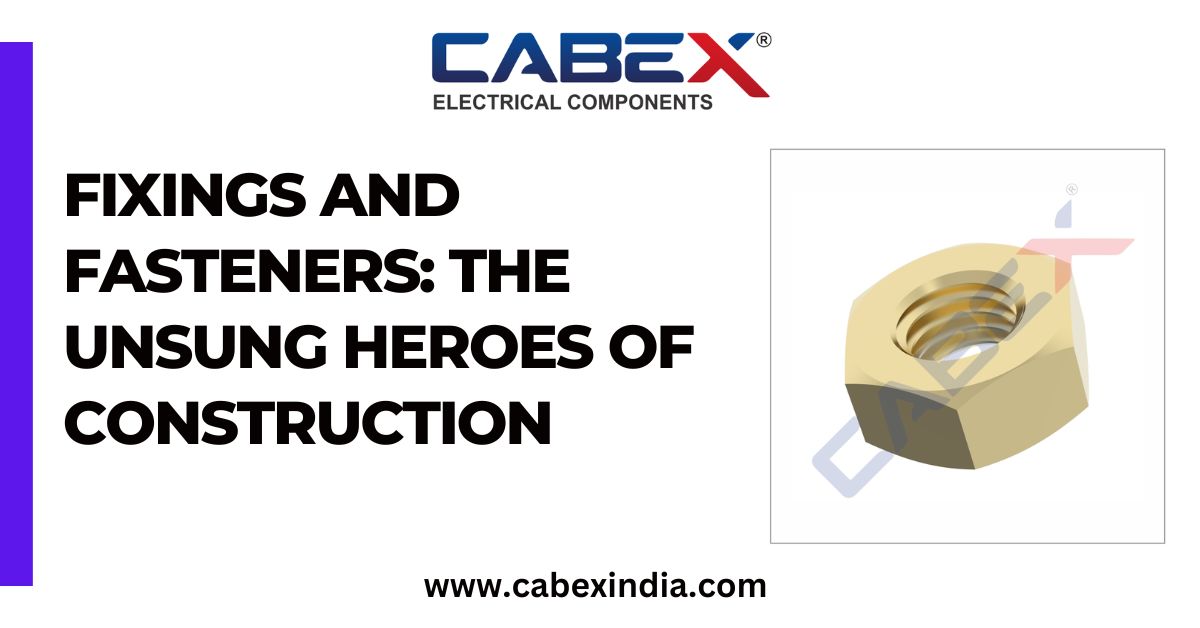Introduction
Fixings and Fasteners , In the grand scheme of construction projects, fixings and fasteners might seem like minor details. But these unsung heroes play a crucial role in ensuring the stability, safety, and longevity of any structure, from towering skyscrapers to cozy bungalows. At cabexindia.com, we understand the importance of having the right fixing for the job. That's why we offer a comprehensive range of high-quality fixings and fasteners to cater to all your construction needs.
This blog post delves into the world of fixings and fasteners, exploring their different types, applications, and selection considerations. We'll also answer some frequently asked questions to equip you with the knowledge you need to make informed decisions when choosing fixings and fasteners for your next project.
Types of Fixings and Fasteners
The vast world of fixings and fasteners encompasses a diverse range of products, each designed for specific applications. Here's a breakdown of some common types:
- Screws: These threaded fasteners come in various shapes, sizes, and materials like steel, brass, and nylon. They are typically used with nuts or driven directly into pre-drilled holes.
- Nails: These pointed metal rods are hammered into wood or other materials for permanent or temporary fastening. They come in various lengths, thicknesses, and coatings for specific purposes.
- Bolts: These are cylindrical threaded fasteners with heads on one end and nuts on the other. They are used for high-strength applications and often require washers for better load distribution.
- Anchors: These specialized fasteners are used to secure objects to concrete, brick, or masonry walls. They come in various types like expansion anchors, wedge anchors, and chemical anchors, each with its own installation method.
- Rivets: These permanent fasteners consist of a hollow shank with a head on one end. The shank is inserted through pre-drilled holes in two pieces of material, and the tail end is hammered to create a bulb, permanently joining the materials.
- Adhesives: While not technically fasteners, adhesives play a vital role in modern construction. They are used for bonding various materials, sometimes in conjunction with mechanical fixings for enhanced strength.
Applications of Fixings and Fasteners
Fixings and fasteners have a wide range of applications across various construction sectors, including:
- Building construction: From framing walls and roofs to installing windows, doors, and electrical fixtures, fixings and fasteners are essential for holding buildings together.
- Infrastructure development: Roads, bridges, and other infrastructure projects rely heavily on robust fixings and fasteners to ensure structural integrity and withstand heavy loads.
- Furniture making: Cabinets, shelves, and other furniture pieces require strong fixings and fasteners to assemble components and ensure durability.
- Machinery and equipment: Fixings and fasteners are crucial for securing components in machinery and equipment, ensuring proper function and safety.
- Interior design: From hanging shelves and pictures to installing fixtures and fittings, fixings and fasteners play a role in creating functional and aesthetically pleasing interiors.
Choosing the Right Fixings and Fasteners
Selecting the right fixings and fasteners for your project requires careful consideration of several factors:
- Material: The type of material you're working with (wood, metal, concrete, etc.) will determine the appropriate fastener material and its compatibility.
- Application: Consider the specific function of the fixing. Is it for high-strength load-bearing applications, or is it for lighter-duty tasks?
- Environment: Will the fixing be exposed to harsh weather conditions, chemicals, or high temperatures? Choose a material and coating that can withstand the environment.
- Size and Strength: The size and strength of the fixing should be sufficient to handle the intended load it will bear.
- Finish: Consider the aesthetic aspect, especially for applications where the fixing will be visible. Choose a finish that complements the overall design.
FAQs about Fixings and Fasteners
- What's the difference between a screw and a nail?
Screws have a threaded shank that allows them to be screwed into a pre-drilled hole, creating a stronger and more secure fastening compared to nails, which are simply hammered in.
- What are the different types of screw heads?
Common screw head types include flat head, Phillips head, Robertson head, hex head, and torx head. Each type requires a specific screwdriver for installation.
- What's the best type of anchor for concrete?
The best type of anchor for concrete depends on the application and load requirements. Expansion anchors, wedge anchors, and chemical anchors are some common choices.
- Can I use adhesives instead of fixings and fasteners?
While adhesives can provide a strong bond, they might not be suitable for all applications,
Conclusion
In conclusion, fixings and fasteners are the unsung heroes of the construction industry. They play a pivotal role in ensuring the structural integrity, safety, and longevity of buildings and structures. By understanding the various types, applications, and selection considerations, you can make informed decisions when choosing the right fixings and fasteners for your specific project.





Comments